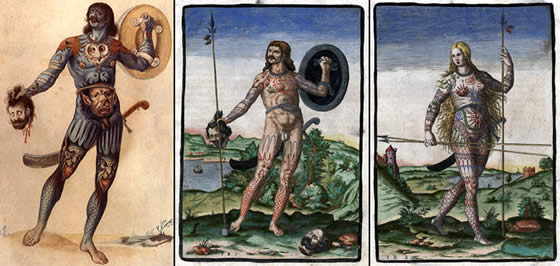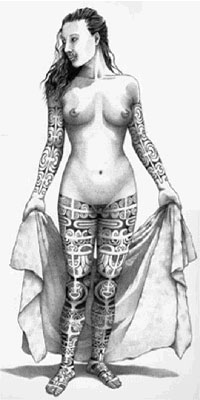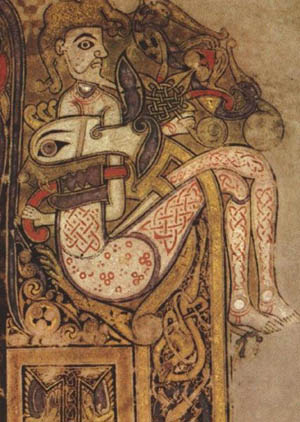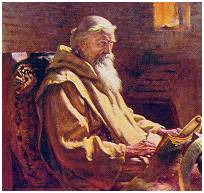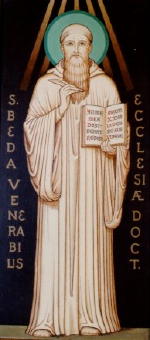“What greater glory could there be Than to be clothed with God? He drew His skin upon my skin, His blood upon my blood.” – 1754 English Hymn
For thousands of years, tattoos have adorned the skin of many of our ancestors. It was said that in many tribes, that no one could tattoo other tribal members, but the priests; and the art of tattooing, like their religious customs, was passed down within the same families from one generation to the next. Hence, just like the priesthood was a profession whose teachings were hereditary, so was the marking of one’s skin.
These ancient accounts of painted men and tattoos come to us from all over the globe. However, my research below proves a biblical tattoo connection between the East and West that had really gained momentum when a dominant class of tattooed rulers from the early Egypt and Greek royal dynasties in approximately 2100 – 1500 BC had spread their custom around the world.
TATTOOED EGYPTIAN MUMMIES
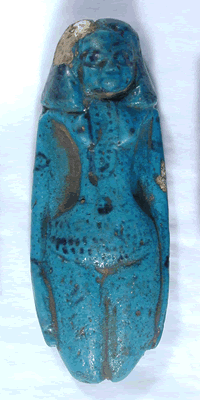 Many examples of painted or heavily tattooed mummies have been discovered all over the world in the last century. Some of the earliest being found in Egypt where some of the most famous mummies were found in the year 1891. These tattooed Egyptian royal mummies were exhumed at Deir el-Bahari by French Egyptologist Eugène Grébaut. They are dated from the Dynasty XI (c.2134-1991 BC) and one of these mummies was a female identified with tattoos on her body by the name Amunet, a Priestess of the goddess Hathor at Thebes.
Many examples of painted or heavily tattooed mummies have been discovered all over the world in the last century. Some of the earliest being found in Egypt where some of the most famous mummies were found in the year 1891. These tattooed Egyptian royal mummies were exhumed at Deir el-Bahari by French Egyptologist Eugène Grébaut. They are dated from the Dynasty XI (c.2134-1991 BC) and one of these mummies was a female identified with tattoos on her body by the name Amunet, a Priestess of the goddess Hathor at Thebes.
And archaeologist Geoffrey Tassie writes;
The use of many artifacts can only be inferred from their context and association, and tattoo needles are no different, although, if sufficiently well-preserved, scientific analysis of their tips may identify traces of blood or the pigment used to create the tattoo.
Robert Bianchi writes in the book, ‘Tattooing and Skin Painting in the Ancient Nile Valley’;
The priestess Amunet and the figurines…have an undeniably carnal overtone. The eroticism that is undoubtedly associated with Egyptian tattoo of the Middle Kingdom correlates with the prevailing religious attitude that linked physical procreation with the loftier aspirations of resurrection in the Hereafter.
Other mummies that were found in Deir el-Bahari show that their faces had been painted and anointed for burial in a ritual performed for the afterlife;
“The thick coats of colour which they still’ bear are composed of ochre, carmine (or pounded brick) and animal fat.” (Maspero, Dawn of Civilisation, Eng. Tr,, p. 54, note s) These are also forms of the Anointed One, who was made so by extreme unction more primitively applied to Osiris the Karast Mummy.
TATTOOING MOVES FROM THE DACIANS IN THE EAST TO THE PICTS IN THE WEST –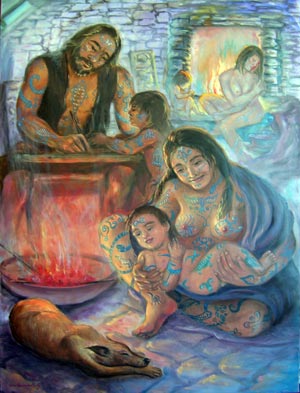
More stories of a painted peoples and a heavily tattooed tribe had occurred at the turn of the millennia. However, these stories come to us at a much later date than the Egyptian tattooed mummies and on the other side of the globe in ancient Scotland, Ireland, Gaul and Britain. For the markings they had placed on their bodies, these peoples were known by historians as the Picts and their stories have been passed down to us by some of the earliest historians of the 6th Age such as Tacitus, Solinus, Claudian and Bede. Caesar had used the term Pictones and in Welsh literature, they were called the Gwyddyl Ffichti, Goidelic Picts, or Pictish Goidels. Prior to these historical accounts, one of the oldest designations of these peoples comes to us from the Greeks who had named the British Isles, Pretanikai Nesoi, (Pretan(n)ic Isles or Pretan-ik islands) which then later gave their name of the Picts (Picti, Pictavi or Pictones) who would have also been known in the East by the Greek as the Illyrians, Dacians or Thracians.
One of the first physical descriptions of the Picts was written about in approximately 240 AD by the Roman civil servant and historian Herodian of Syria, sometimes referred to as ‘Herodian of Antioch.’ He calls these same peoples simply Britains, but he describes them as Picts, or painted peoples;
They mark their bodies with various pictures of all manner of animals, and therefore they clothe not themselves, lest they hide the painted outside of their bodies.
At the end of the 400 AD, poet Claudian had stated that the Picts not need wear clothes lest they should conceal the pictures, and this implies that the tattooing was not confined to their faces and in his Against Rufinus (book 1) polemically portrays the tribes of Scythia as prototypical barbarians:
- There march against us a mixed horde of Sarmatians and Dacians, the Massagetes who cruelly wound their horses that they may drink their blood, the Alans who break the ice and drink the waters of Maeotis’ lake, and the Geloni who tattoo their limbs: these form Rufinus‘ army.
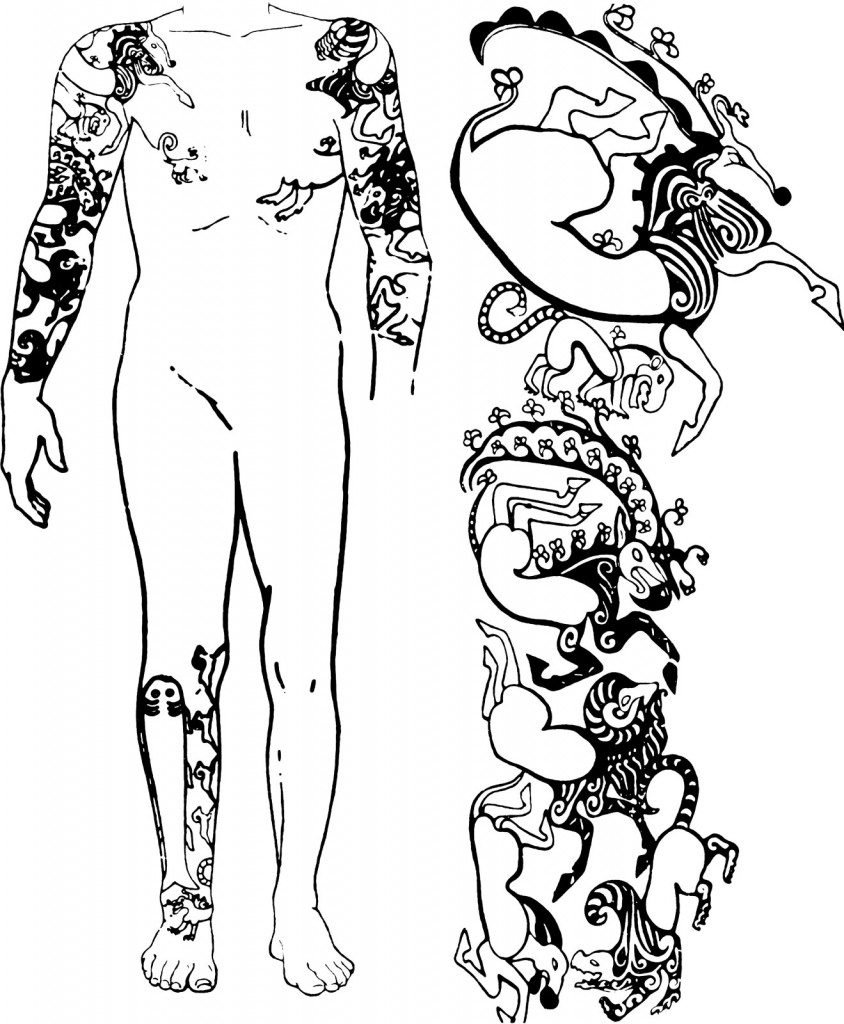 Isidore of Saville in 600 AD had said the word Pict in the Scottish language had meant “tattooed,” and he wrote that the Scoti were named in their own tongue from their painting of the body and they were tattooed by means of iron points and ink, with the marking of various figures. The Father of English History and Doctor of the Catholic Church, Saint Bede (Beda) had said the Picts had first came from Germany and then Scythia. He states that amongst the Scythians are the ancient inhabitants of Norway, Sweden, and Denmark, the Daci (Dacians), Getas (Getoe), and other nations. Bede also mentions that the first Roman writers had spoken about these peoples who had a custom of tattooing their bodies with tribal emblems.
Isidore of Saville in 600 AD had said the word Pict in the Scottish language had meant “tattooed,” and he wrote that the Scoti were named in their own tongue from their painting of the body and they were tattooed by means of iron points and ink, with the marking of various figures. The Father of English History and Doctor of the Catholic Church, Saint Bede (Beda) had said the Picts had first came from Germany and then Scythia. He states that amongst the Scythians are the ancient inhabitants of Norway, Sweden, and Denmark, the Daci (Dacians), Getas (Getoe), and other nations. Bede also mentions that the first Roman writers had spoken about these peoples who had a custom of tattooing their bodies with tribal emblems.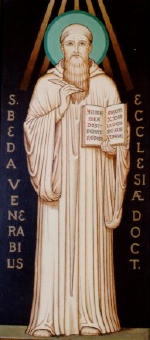
The descriptions that Bede had left in the ninth century were of the tattooed Daci, that were also a branch of Scythians who had inhabited the West in lands such as Norway, Sweden, and Denmark in the West, were the same exact tattooed tribe from the East known as the Greek Dacians.
In the book, The history of Scotland… to the present time, author George Buchanan says that the tribes of the Geloni and the Getoe tattooed themselves and are described as—
“the Geloni, who delight
Their hardy limbs with iron to imprint.”
And of the others it is said—
“The nobles of the long-haired Getoe sat
In council, skin-clad, and their bodies bore
The seamy ornament of many a scar.”
The same Getae that Buchanan states are from Ireland and Scotland are the same tribe that Bede also mentions being found in Norway, Sweden, and Denmark. However, we can locate these peoples at a much earlier date around 1500 BC., but this time we will find them far away from the Scandinavian shores. It is in the far East between the Isker, Yantra and Danube rivers where we also can locate this tattooed branch of Scythians who were also named the Getae and Dacians just like their cousins who came later in the West.
These tribes were said to have originally conquered and merged with the local indigenous Indo peoples known as the Danubian farmers; that I believe was the first beginnings of of the Indo-European branch of the Danaoi, or Danaans (Tribe of Dan), who had claimed descent from the ancient Greek King Danaus (Tanaus or Dan I). This tribe would also become known as the ancient Phoenician Tyrians who were the red haired sons of Cain who had named their priests Cohanim (Kohanim). In the Torah, the priests of Baal are referred to as Cohen or Kohen or plural: Cohanim or Kohanim, which is a Hebrew word for priest or king; and the word or Bol-Khan, specifically refers to the priests of Baal who in Homer’s Iliad are the “Danaans” or “tribe of Danaë,” grandchildren of Belus (Phoenician ‘Baal’) who gave their name to the “Argives.”
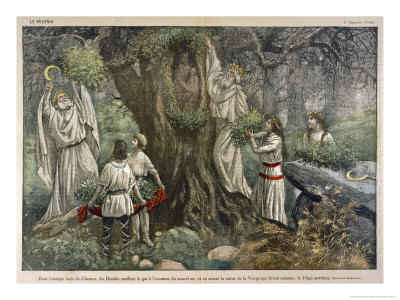 The Irish Druids whose families were Picts, had also claimed decent from the Phoenicians and the Priesthood of Baal. They had learned these religious and tattoo customs from their ancestors in the East known as the Danaoi, or Danaans (Tribe of Dan). The Druids and Picts would be considered the Western branch of the Tribe of Dan, who in the fourth through ninth centuries we can find just off the coast of ancient Scotland on what was then known as “the island of the Druids (Innis nan Druidhneah).”
The Irish Druids whose families were Picts, had also claimed decent from the Phoenicians and the Priesthood of Baal. They had learned these religious and tattoo customs from their ancestors in the East known as the Danaoi, or Danaans (Tribe of Dan). The Druids and Picts would be considered the Western branch of the Tribe of Dan, who in the fourth through ninth centuries we can find just off the coast of ancient Scotland on what was then known as “the island of the Druids (Innis nan Druidhneah).”
It was on this mystical remote island in the sixth century that the druid priesthood had become Christian Gnostics and would then become known by the name of the ‘Culdees.’ This was the time period when the Celtic Druid Church had merged with the Roman Church to become the New Universal Church which was the first true spark of Christianity in those lands. To signify this event, the island of the Druids would then be renamed after the churches founder, Saint Columba to then become known as “the island of Columba of the Cell (Hii-colum-kiU or Icolmkill), or more commonly today, Iona.” Of course, before they had become known as the priesthood of the Culdees or the royal family of the Uí Néill, this family of Scots were part of a tribe of painted peoples who were called the “Picts (Picti)”, who are also the same tribe of the Getae and Dacians that Bede mentions.
The Head of the New Universal Church, Saint Columba was an ancestor of the Uí Néill, a royal descendent from Niall of the Nine Hostages who was from one of the earliest royal families of the Scots (Picts). When Columba had taken the Chair of Saint Peter and merged with that of Saint Paul in Rome on the island of Iona, this had formed the new Universal Brotherhood between the Scots (Picts) and Rome that we know of today as the Catholic Church. The Culdees would then become known in the Bible as the Levites whom Bede describes as allegorically attached to the Catholic Church.
It was on the island of Iona in approximately the ninth century where the ex-Pictish Druids, the Culdees were still performing the ancient art of their ancestors known as tattooing. Evidence of this fact can be found in Iona which was also the location where one of the most famous books was ever made; the illuminated Book of Kells. It is in this ancient book where we can find the light via apocalyptic clues left to us by this same Culdee priesthood whom I believe had also written the New Testament and the Book of Revelation about this same time. They would also be later known as the Johannites who were some of the first gnostic Christians in the West that became the predecessors to the Knights Templar and Freemasons.
The magical Book of Kells that had been created on the Island of Iona has a lot of secret occult symbolism encoded in its artwork. With the Culdees being direct descendants of the Picts, it is only natural that we will find evidence of tattooing symbolized in their illuminated manuscripts. For example, we can find the figure of a naked man or warrior whose body is completely covered with various types of ” blue marks” and holding a spear with the sacred text around him. These tattoos are also described by author Gerald Massey in his book, Ancient Egypt, the Light of the World: A Work of Reclamation and …, Volume 1;
the description of the Picts found in Claudian’s De Bella Getico (xxiv., 417-18), “ferroque notatas porlegit examines Picto moriente figuras.” This is shown by an initial letter in the Book of Kells—a facsimile of which has been published by the Palaeographical Society, containing the figure of a man quite naked, the body being covered all over with significant marks just as the hieroglyphics are described by Boece, who affirms that in “all their secret business the ancient Britons wrote with cyphers and figures of beasts made in manner of letters” which he identifies with the hieroglyphics of Egypt.
Thus the woad-bedaubed men stigmatized as savages become the more intelligent illustrators of Totemic times and customs who wore the stigmata of Tattoo, and the Picts or painted men are the men who carried the Totemic marks either painted or branded on the living book of their own bodies. They were not merely dyeing their flesh for decoration, but making figures for use that could be read by others at sight. Even the raising of cicatrices in the flesh which preceded tattooing was an Egyptian custom. On the bas-reliefs of the Temples at Philae and Ombos the bosoms of goddesses and queens are scored with long incisions which, starting from the circumference, united in the centre round the nipple of the breast. (Maspero.)
Gerald Massey, like myself believes that the art of tattooing had first come from the East and had been a custom in Egypt long before it had arrived in the West with the tribe of the Picts. There are even historical accounts of these Picts who then became Culdees in the early Celtic-Roman Catholic Church where the priests were often tattooing one another in the back rooms of these same said Christian churches that in reality were old Celtic-Druid churches that had been newly converted to Christianity. As they found out, old customs and rites are difficult to stop all at once.
Pope Adrian in 787 AD, who had heard accounts of these tattooed men in Britain had this to say to them; “speak of God as having made man beautiful, and of the pagans of this country as “having by a diabolical impulse added to him most foul scars,” and “if anyone endured for God’s sake this injury of being dyed, he would therefore certainly receive a great reward.”
This was when a New Testament (New Law) was made that had been incorporated from the Old Testament and where this same said brotherhood would later ban the art of tattooing calling it a pagan practice that would be considered hedonistic and barbaric by the priesthood. This was the time that I believe that the Catholic Church had outlawed tattooing and proclaimed the marking of one’s skin a sin as seen in Leviticus 19:28 – “‘Do not cut your bodies for the dead or put tattoo marks on yourselves. I am the LORD.
After all, please keep in mind that they were attempting to stamp out paganism and the ancient ritual of tattooing pagan symbols and hereditary tribal tattoos on their skin was in direct conflict with the church.
The new peoples would be an Indo-European branch that are known as the ancient Greek Illyrians, Dacians or Thracians whom historian Aristotle had said that were the descendants of Cadmus and were also known as the Sparti (the sown men). There are written accounts that the Illyrians of the Adriatic tattooed their bodies, hated strangers, and were greatly given to piracy. Like the Picts, these Eastern tribes also had the custom of tattooing and painting their bodies with their tribal emblems which signified their hereditary symbols. Hence, with these facts we can safely say that tattooing had originated in the East long before we learn about this custom from the Picts in Ireland or Scotland and the Gatae in Scandinavia for whom Saint Bede mentions much later after the time of Christ.
Scotland On the Early Kings By E. William Robertson;
The bravest and most numerous of the Scythians, the opponents of the Persian invaders, were “the kings,” or royal tribes, regarding the agricultural and nomad Scythians as their serfs, and united in the worship of Neptune, whilst Vesta was the tutelar goddess of the whole nation. “Kings” were the ruling tribe amongst their predecessors the Cimmerians; and “kings,” or royal tribes, united in the worship of Mercury, from whom they claimed descent, and deeming it a mark of gentle birth to tattoo or paint the body, monopolized the lead amongst the Thracians. The presence of royal tribes is also noticed by Strabo amongst the Sarmatians, but nowhere are they more evident than amongst the ancestry of the Scandinavians and the Germans.
This is when I believe that we had the big meeting of East and West. The merger of Angles and Saxons to form the Anglo-Saxons which would be the official universal blood brotherhood that would spawn a new race of peoples that we can track not only by their stories and tattooed bodies, but also by their DNA. These same tattooed tribes with their birthmarks and DNA I had written about in my articles titled, The Lost Tribe of Dan Found and The BirthMark of Cain.
This article I believe is just more evidence that the Lost Tribe of Dan has been found. Ancient clues that help us connect the East to the West using not only history, but also science that we can now use to put this magnificent history back together again in order to find the truth of our origins and modern society. History illuminated by truth through the historical accounts and descriptions of these peoples left to us by our ancestors, and also the science via tattooed mummies that we can now verify who they were using DNA.
Related Articles and Videos:
- The BirthMark of Cain
- The Lost Tribe of Dan Found
- Who is Baphomet?
- Kohen: The Priests of Baal
- The Culdees Part I
- Sons of Cain: The Serpents of Wisdom
- Dogs of the Sun
- Freemason Nimrod and the Sons of Chaos
- Definition of Nimrod
- Odin – Pharaoh King Dan

Moe is the founder of GnosticWarrior.com. He is a father, husband, author, martial arts black belt, and an expert in Gnosticism, the occult, and esotericism.

